Picture #1: Sunrise light through trees, Mount Rainier National Park, Washington
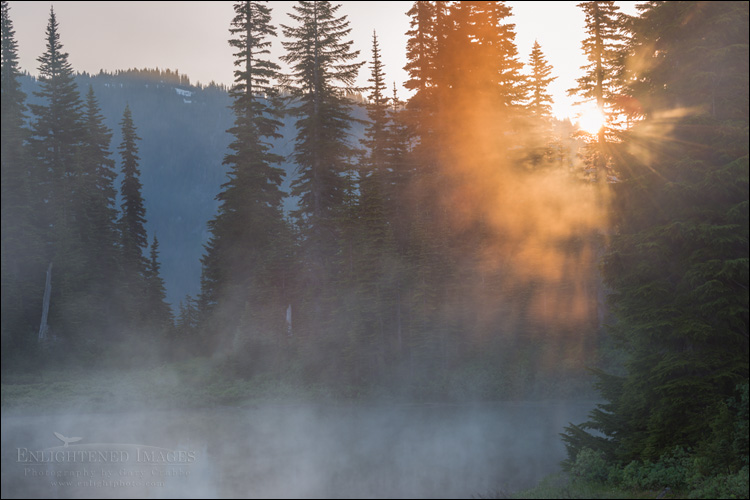
(First let me say how thankful I am to have my blog back up and running normally after it had been hacked earlier this month. I’d also like to apologize to anyone who came to this site via a link only to find an bunch of Viagra ads. And now back to our regularly scheduled programming.)
*** Please leave a comment below and let me know which is your favorite shot. ***
Last summer, while traveling through some of the Pacific Northwest’s most popular National Parks, I had occasion to experience the exact something I’m always trying to teach my workshop students and clients. One of the lessons I want them to learn most is learning to see and use the light to create compelling photos. Many times I’ve seen photographers get so wrapped up in shooting a particular subject right in front of them that they miss something completely special happening at side or behind them.
On this particular morning, I was at one of those “Me Too” locations; a standard easy-to-get-to postcard locations that everyone likes to get. A friend of mine refers to these as the photographic equivalent of low-hanging fruit. In other words, it just doesn’t take much effort or originality to point your camera at an icon scene and press the button. I was traveling with my family, photography was not on the priority list, and the fact that I hadn’t been here in 20 years made the low-hanging, easy target perfectly acceptable.
Picture #2: Trees and morning mist, Mount Rainier National Park, Washington
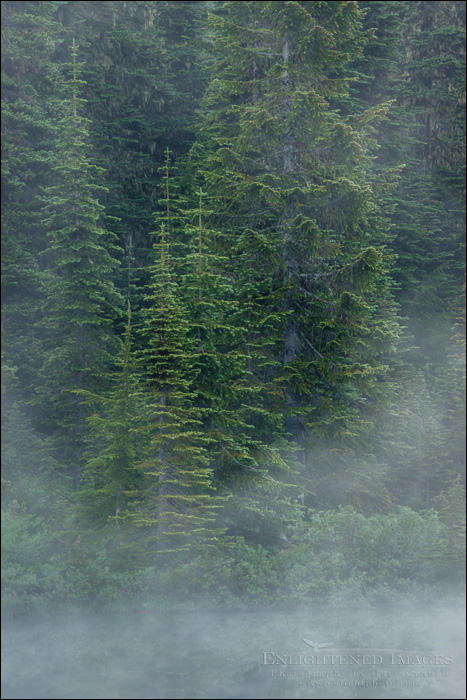
While not crowded by any means, there were a number of other photographers there on this clear morning. While waiting for the light on the mountain, which obviously wasn’t doing anything special, this is what the shaded scene right in front of me looked like: (Photo # 2)
This was certainly pretty, and enough to occupy my attention since there was nothing overly compelling happening with the ‘postcard’ icon shot.
Then as the sun rose above the distant hills, suddenly the morning mist on the very far side of the lake came alive. (Photo #1, top of post)
While I focused on this special light, creating compositions based on what the light was doing, I happened to look over at the other photographers who were still focused on the pretty, but not very special mountain reflection scene directly in front of them. In other words, their ‘subject blinders’ – being too stuck on the subject at hand to fully appreciate the things happening around them, was causing them to miss an ethereal and special moment. What they were pay attention to was secondary, but what they needed to be aware of from a photographer’s perspective, is and most importantly, Light.
Picture #3: Sunrise light through trees, Mount Rainier National Park, Washington
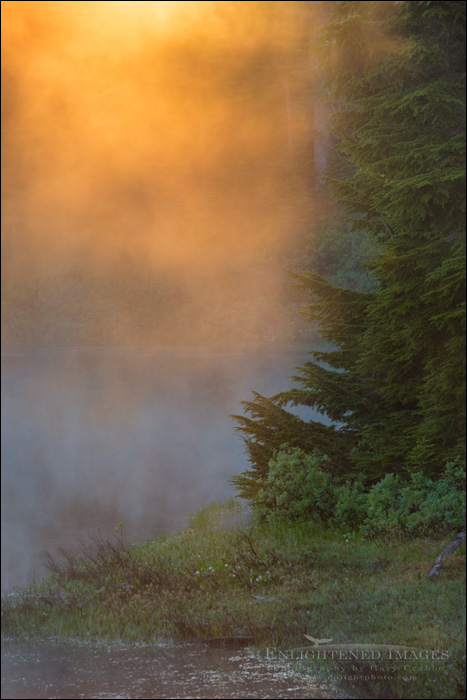
As soon as I saw this bit of direct sunlight trying to push its way through an opening in the trees near the edge of the lake, I immediately went from thinking about the ‘landscape’ to thinking about the light. The light became my subject, and I began composing images relative to where the light was, and how it was interacting with the other subjects at hand, in this case, trees and the mist coming off the water.
Picture #4: Sunrise light through trees, Mount Rainier National Park, Washington
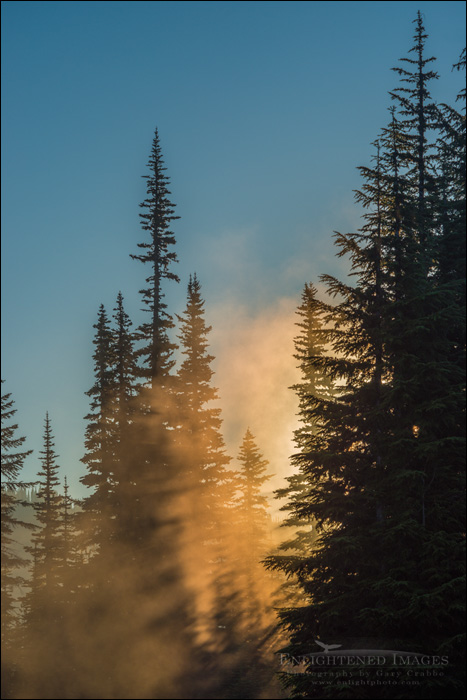
As fast as I could in the quickly changing light and conditions, I would change lenses or use a zoom lens to get what shots I could. I would back off and capture the light in context of a larger scene, or reverse the process and zoom in trying to fill my frame with the part of the scene that I liked the most.
Picture #5: Sunrise light through trees, Mount Rainier National Park, Washington

This play of light and mist dancing in front of me lasted for about 10 minutes before the sunlit mist finally stretched far enough into the scene to become part of that postcard icon mountain reflection shot. I’m sure the other photographers where happy to see this light work itself into their scene, but for all that earlier time when I looked over to see what they were shooting, they were too stuck in the mountain subject to notice what we’re foremost supposed to be paying attention to; the Light. Follow the Light.
Picture #6: Sunrise light through trees, Mount Rainier National Park, Washington
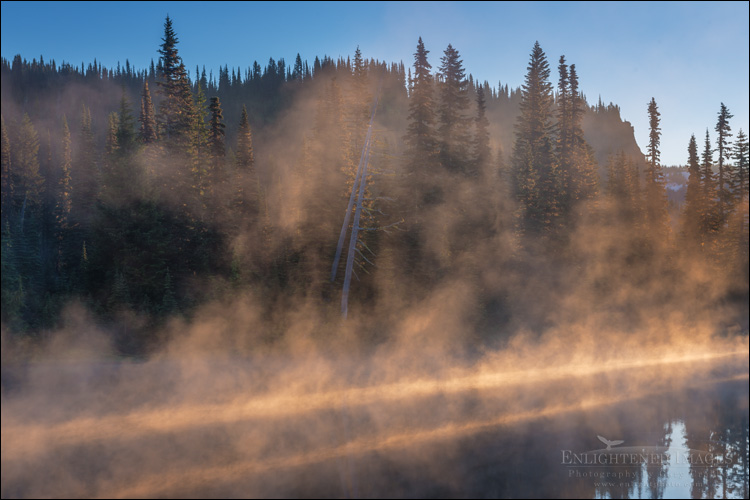
Picture #7: Sunrise light through trees, Mount Rainier National Park, Washington
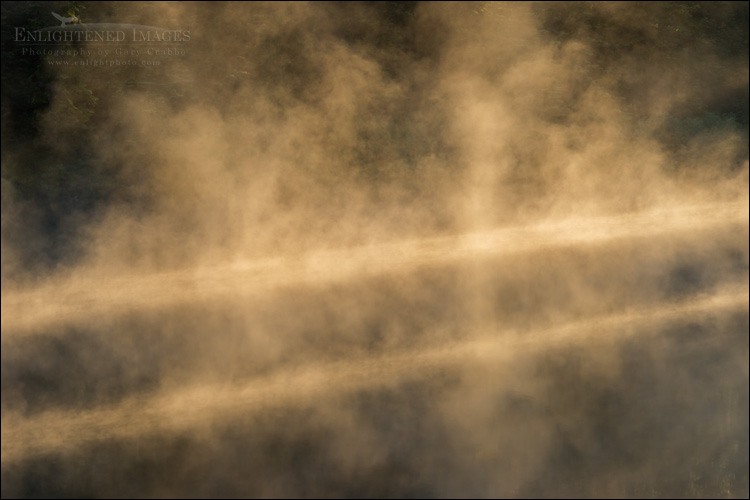
—
I’m very curious if you have a favorite image from the one’s above. If you do, please leave a comment and let me know. I’d love to hear your thoughts as well, or if you have similar stories about similar incidents, please feel free to share them.
—

If you like this post , I would greatly appreciate it if you’d consider sharing this with your friends using one of the Social Media sharing buttons located at the top of this post. You can also sign up to receive free updates by email when future posts are made to this blog.

—

—
Gary Crabbe is an award-winning commercial and editorial outdoor travel photographer and author based out of the San Francisco Bay Area, California. He has seven published books on California to his credit, including “Photographing California; v1-North”, which won the prestigious 2013 IBPA Benjamin Franklin Gold Medal award as Best Regional title. His client and publication credits include the National Geographic Society, the New York Times, Forbes Magazine, TIME, The North Face, Subaru, L.L. Bean, Victoria’s Secret, Sunset Magazine, The Nature Conservancy, and many more. Gary is also a photography instructor and consultant, offering both public and private photo workshops. He also works occasionally a professional freelance Photo Editor.

Thanks for a super blog Gary. You are so right and as I am maturing as a photographer, I appreciate what you have explained. For me I like the tight shot- no 5. The rays really pop and you have enough in the scene for context. Well done!
I like #5! They are all beautiful shots but I think #5 shows the most detail with the light.
Thanks for sharing.
Very well said, Gary. Often we are so focused on the landscape we came to shoot that we can forget about the way the light is playing all around us. Being able to adapt quickly and see things for what they are are two hallmarks of an experienced photographer.
Oh, and it’s pretty hard to pick a favorite from this crop. I really like #2, but #3 is something completely different and just as beautiful.
Wonderful blog and I like #5 too. It’s kind of ironic that I’ve come across your blog Gary, because this year I’m taking a journey into the light. I have spent too much time on my subject, now it’s time to see the light.
I love these images! I love #4 & #5 the most.
Hi Gary, I love your work and aspire to produce similar from my own region. May I have permission toreblog your post on my site? I would like to show my followers your work ad you seem to come from the same mind space I do. Although I’m comparatively new to the industry next to you. You are inspiration for me.
Thanks for the great blog.
Cheers Robert
Hi Robert.
Thanks for the very kind comments. Absolutely you can re-share this on your blog. Please include a link back here to my site, and let me know once you’ve posted it. Cheers & many thanks again, Gary.
I remember one time at a beach in Monterey taking pictures at sunset. Someone was also taking pictures and I showed the picture I had just taken (but in the opposite direction of where they did). They wanted to know where I had taken that picture of the sea of fire. I told them to turn around.
Greg:
“I told them to turn around.” – Classic. Pure classic. 🙂
Gary, we clearly like #3 way above the others.
Reason-It is a tight well structured composition, and vey well exposed.
I like #5 the best but #3 is a very close 2nd.